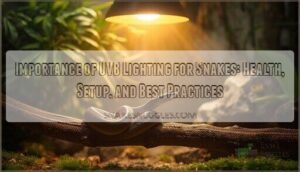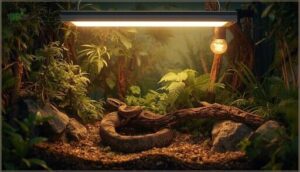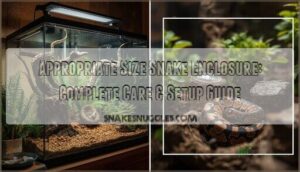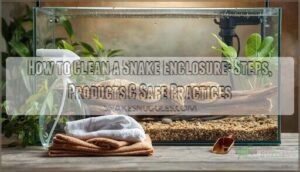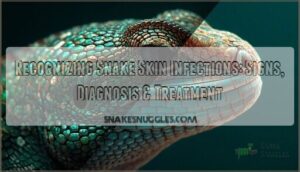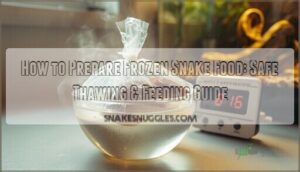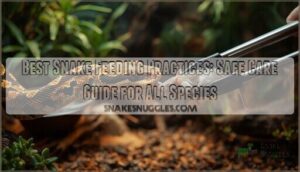This site is supported by our readers. We may earn a commission, at no cost to you, if you purchase through links.
A snake basking under the wrong light can look healthy for months—until hidden bone problems surface, or its feeding slows to a crawl. The importance of UVB lighting for snakes isn’t obvious at first glance, but this invisible force powers everything from calcium absorption to immune strength. Without UVB, even the most carefully curated enclosure misses a critical ingredient for long-term health.
The right spectrum keeps bones strong, scales vibrant, and natural rhythms in sync. Whether you keep a desert dweller or a rainforest native, understanding UVB’s role is the foundation for safe, thriving reptile care.
Table Of Contents
Key Takeaways
- UVB lighting is essential for snakes because it triggers vitamin D3 production, which supports calcium absorption and prevents metabolic bone disease.
- Matching UVB intensity and placement to your snake’s natural habitat and species ensures healthy bones, vibrant scales, and proper immune function.
- Regular monitoring of UVB output, proper bulb selection, and maintaining a natural day-night cycle help avoid hidden health problems and promote overall well-being.
- Consulting with reptile veterinarians and using UV meters can fine-tune your setup, preventing both underexposure and overexposure risks.
Why UVB Lighting Matters for Snakes
UVB lighting plays a key role in your snake’s health and daily life. Understanding why it matters helps you make better choices for their habitat. Here’s what you need to know when considering enclosure options.
The Role of UVB in Reptile Physiology
Think of UVB lighting as the switch that powers your snake’s physiological balance. UVB exposure triggers vitamin D3 production, which drives calcium absorption and protects against metabolic bone disease. It fuels reptile hormones, aids skin regeneration, and keeps circadian rhythms on track.
UVB lighting is the switch that powers your snake’s health, fueling vitamin D3, calcium absorption, and metabolic balance
Without UVB metabolism, your snake’s health can unravel—impacting growth, immunity, and overall well-being. Understanding the role of UVB lighting effects is vital for maintaining peak health in snakes.
Differences Between UVB and UVA for Snakes
While UVB lighting for snakes powers vitamin D3 synthesis and calcium metabolism, UVA lighting shapes daily behavior and mood. UVB Spectrum is mostly invisible, but UVA Visibility lets snakes see and interact with their world. Here’s how they differ:
- UVB exposure affects bone health
- UVA lighting boosts activity
- UVB intensity regulates metabolism
- UVA influences feeding
- UVB prevents disease
Proper lighting is essential, as inadequate UV exposure can cause health issues.
Evolution of UVB Lighting Knowledge in Snake Care
Years ago, early misconceptions led many to skip UVB lighting for snakes, assuming diet alone was enough. Research breakthroughs flipped that thinking, showing UVB lighting effects on snakes go far beyond bones.
Husbandry shifts now prioritize UVB for all captive snake care. Ongoing studies and ecological insights keep updating best practices, proving that snake health and UVB are closely linked.
UVB’s Impact on Snake Health
UVB lighting does more than just brighten your snake’s habitat—it’s a key player in their overall health. You’ll notice the difference in everything from bone strength to immune support.
Here’s what UVB can do for your snake’s well-being.
Vitamin D3 Synthesis and Calcium Metabolism
Did you know cutaneous synthesis of vitamin D3 in snakes can spike over 200% with proper UVB exposure? This process jumpstarts calbindin activation, fueling calcium metabolism and bone mineralization—key for strong, healthy snakes. You’ll see the difference:
- Reliable hypocalcemia prevention
- Clear dose-response patterns in skin and blood
- UVB lighting for snakes promotes overall health
Prevention of Metabolic Bone Disease
When dietary calcium intake falls short or UVB bulb choice is poor, metabolic bone disease creeps in—often silently. Early MBD signs like jaw deformities and weak bone development are common.
Regular veterinary MBD screening, paired with proper UVB lighting, aids vitamin D3 synthesis and calcium absorption. Addressing husbandry risk factors keeps your snakes safe from this preventable disorder.
Immune System Support and Disease Resistance
When you provide proper UVB lighting, you’re not just brightening the enclosure—you’re boosting snake health in real, measurable ways. Here’s how UVB Immunomodulation aids immune function and Disease Resistance:
- Increases white blood cell activity
- Enhances Vitamin D3 synthesis
- Improves Immune Health
- Delivers Antimicrobial Effects
- Lowers risk of reptile infections
Effects on Skin, Scales, and Overall Well-being
Healthy skin is more than just looks—it’s a sign of overall reptile health. UVB lighting promotes Skin Morphology and Damage Repair, encouraging proper shedding and sturdy scale quality. You’ll also see Antimicrobial Effects, reducing skin infections, and even richer skin pigmentation. These health effects extend to Behavioral Health, with improved wellbeing and more natural activity.
| Benefit | Health Effect |
|---|---|
| Skin Morphology | Better shedding |
| Antimicrobial Effects | Fewer infections |
| Coloration Enhancement | Vibrant pigmentation |
| Behavioral Health | Increased activity |
Species-Specific UVB Requirements
Not every snake needs the same amount of UVB light. Their natural habitats and daily routines play a big role in what works best.
Here’s how different enclosure setups can meet those unique needs.
Desert Vs. Rainforest and Nocturnal Snakes
Ever wonder why a Desert Snake basks for hours, while rainforest species hide in dappled shade? UVB Exposure needs are shaped by habitat—desert snakes thrive under intense UVB lighting, while those from Rainforest Habitats and nocturnal species require gentler, filtered light.
Smart snake habitat design means matching reptile lighting to each species’ adaptation and natural Nocturnal Behavior for real health benefits.
Ferguson Zone Classification and UVI Index
Did you know your snake’s health hinges on matching its UVB exposure to Ferguson Zone guidelines? The Ferguson Zone system, built on UVI Measurement and Lighting Standards, helps you calibrate UVB intensity for safety and well-being. Using UV meters, you can fine-tune Reptile Spectrums and verify your enclosure’s UV index fits your snake’s natural habitat.
- Shade-dwelling species (Zone 1)
- Occasional baskers (Zone 2)
- Full-sun baskers (Zone 3)
- Mid-day sun baskers (Zone 4)
- UVI Index guides UVB Calibration
Research Findings on UVB Needs in Different Snake Species
Imagine two snakes from the same genus needing wildly different UVB dosage—this isn’t rare. Recent research highlights UVB variability driven by ecological factors, not just genetics.
Arboreal and desert species adapt their physiology and behavior to unique UVB lighting needs. Studies show vitamin D3 levels in snakes and their overall health respond directly to species adaptation and UVB exposure.
Setting Up UVB Lighting for Snakes
Getting UVB lighting right is key to your snake’s health and comfort. There are a few important steps you’ll want to follow when setting up their enclosure.
Here’s what you should keep in mind as you get started.
Choosing Reptile-appropriate UVB Bulbs
Selecting the right UVB light sources for your snake means weighing bulb types, UVB output, and safety features.
T5 fluorescent tubes offer strong UVB intensity for desert species, while coil bulbs suit lower UVB lighting requirements but need frequent replacement.
Brands like Arcadia and Reptisun provide reliable options. Always factor in lifespan guidelines and choose bulbs designed for reptiles.
Proper Placement and Distance for Optimal Exposure
Once you’ve chosen the right bulb, getting the placement right matters just as much. Bulb distance shapes UVB intensity—most species need their basking area 12–18 inches from the lamp. Mesh barriers can cut UVB exposure by half, so factor that in.
Use meter monitoring to track UVI gradients and adjust for your snake’s species needs and enclosure design.
Maintaining a Natural Day-night Cycle
Getting bulb placement right is just the start—your snake’s health depends on steady light cycle management. Photoperiod control mimics natural daylight simulation, syncing circadian rhythms and biological synchronization. For best results, set timers to maintain a 10–14 hour daynight cycle. You’ll notice:
- Predictable feeding and activity
- Proper hormone balance for shedding
- Reduced stress and abnormal behaviors
Monitoring UVB Intensity and Bulb Replacement Schedules
Once you’ve nailed your lighting cycles, regular UVB metering keeps your UVB output on target. Use a UV meter to track UV intensity at basking spots, matching Ferguson Zone needs for your species.
Mark bulb replacement dates—most UVB lighting for reptiles fades after six to twelve months, even if the light still looks bright. Consistent monitoring means consistent health.
Best Practices for Safe and Effective UVB Use
Getting UVB lighting right takes more than just picking a bulb and plugging it in. There are a few key steps you’ll want to follow to keep your snake safe and healthy.
Here’s what you should keep in mind as you set up your enclosure.
Integrating UVB With Temperature and Habitat Design
Ever notice how snakes always seek out that perfect sunbeam? In reptile habitat design, integrating thermal gradients with UVB lighting means your basking zone offers both warmth and essential UVB intensity. Overhead bulbs should overlap the basking area, letting snakes self-regulate exposure.
Thoughtful enclosure design—multiple hides, shaded retreats, and proper habitat lighting—gives your snake real choices, just like in nature.
Using UV Meters for Accurate Monitoring
With a UV meter in hand, you gain control over UVB lighting intensity and exposure. Place the meter at snake level—not just near the bulb—for accurate UVB spectrum analysis.
Regular UV meter calibration helps track UVB decay rates, ensuring your setup delivers safe, effective UVB output. Monthly checks keep lighting intensity consistent, preventing hidden deficiencies in your snake’s environment.
Consulting Reptile Veterinarians for Individualized Care
Precision in reptile husbandry starts with Veterinary Guidance. UVB Consultations with a reptile veterinarian guarantee your snake’s care matches its unique biology. Species Expertise means no guesswork—just Individualized Care for peak reptile health and lighting. You’ll sidestep common pitfalls and support long-term well-being.
- Custom UVB schedules
- Diagnostic bloodwork
- Habitat design tips
- Follow-up evaluations
- Dietary integration
Common Mistakes and How to Avoid Them
Think your UVB lighting setup is foolproof? Many snake keepers miss the mark on Bulb Replacement, Distance Issues, or creating a proper UV Gradient.
Bulb Selection matters—choose reptile-specific tubes, not coils. Overexposure Risks climb if snakes can’t self-regulate.
Prioritize Reptile health and lighting by testing your UVB output regularly for best Snake care and UVB lighting, ensuring true snake health and wellbeing.
Frequently Asked Questions (FAQs)
Can UVB lighting harm snakes if misused?
Imagine a ball python suffering severe ocular damage and photodermatitis risk from UVB overexposure—this isn’t rare.
Spectrum dangers and improper setup can trigger health issues, undermining snake health. Safe implementation is essential for responsible reptile health and snake care.
How does UVB affect snake breeding behavior?
UVB exposure boosts snake courtship and breeding cycles by enhancing vitamin D3 synthesis, which regulates reproductive hormones.
Proper UVB dosage promotes fertility, egg quality, and overall reproductive health, leading to more active breeding behaviors and healthier offspring.
Do wild snakes seek out UVB exposure naturally?
In the wild, snake behavior reveals a natural UVB seeking instinct. Many snake species actively bask in sunlit areas, adapting their positioning and daily routines to maximize UVB exposure according to their habitat’s Ferguson Zone and environmental conditions.
What signs indicate a snake is getting too much UVB?
Signs of UVB Overexposure in snakes include scale damage, eye irritation, and behavioral changes like hiding or refusing food.
Toxicity symptoms—such as abnormal shedding, swelling, and metabolic bone disease—may arise if UVB lighting and vitamin D3 levels spike.
Are there alternatives to UVB lighting for snake health?
Think of snake health like balancing a recipe—Dietary Supplements, LED Lighting, Heat Lamps, and Natural Sunlight can help, but none fully replace UVB lighting.
Without UVB, vitamin D3 alternatives struggle to prevent metabolic bone disease or meet reptile lighting requirements.
Conclusion
Imagine your snake’s habitat as a well-tuned orchestra—each element, from heat to humidity, plays its part. But without the importance of UVB lighting for snakes, the melody falters, and silent harm creeps in.
UVB is the conductor, guiding bone strength, immunity, and vitality. When you choose and monitor UVB with care, you guarantee every note rings true.
Your snake’s health thrives when you respect this invisible force—making you not just a keeper, but a guardian of harmony.
- http://www.jzar.org/jzar/article/view/150
- https://reptilesandresearch.org/articles/do-snakes-need-uvb
- https://www.youtube.com/watch?v=N53Fsay5TKY
- https://reptilesmagazine.com/rethinking-reptile-lighting/
- https://www.thebiodude.com/blogs/reptile-and-amphibian-lighting-faqs-and-help/introduction-to-uvb-and-reptiles-part-1

